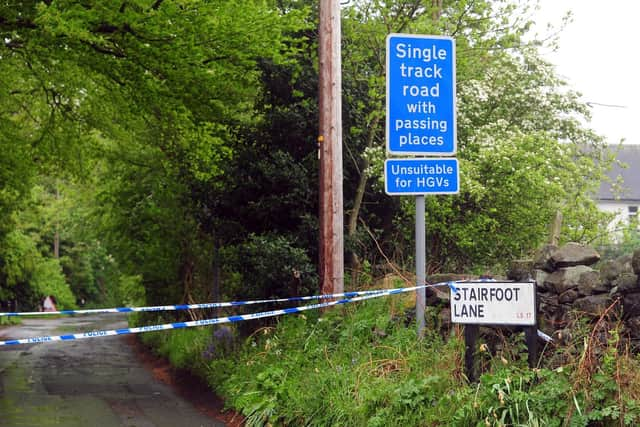Leeds mum killed by controlling husband planned to leave him - review findings
and live on Freeview channel 276
Neighbours had repeatedly complained about noise and disturbances at the home that Sinead Wooding shared with her husband, but a Domestic Homicide Review found the "most explicit" information about domestic violence and abuse was never expressed to police and other professionals.
Ms Wooding's partially burned body was discovered in woods near Stairfoot Lane, Alwoodley, on May 14, 2017.
Advertisement
Hide AdAdvertisement
Hide Ad

She had been killed four days earlier at the family home in Reginald Mount, Chapeltown, by her husband Akshar Ali, and his friend, Yasmin Ahmed. The pair were each jailed for life with a minimum term of 22 years in January 2018.
Following the death of 26-year-old Ms Wooding, Leeds City Council commissioned the review to examine the contact that 20 different agencies had with her between September 2015 and the time of her death.
In a report now made publicly available, it is clear that mum-of-four Ms Wooding had been the victim of what is now widely recognised as controlling or coercive behaviour.
It details regular complaints to the council's housing service from neighbours about noise and disturbances at the house dating as far back as March 2016.
Advertisement
Hide AdAdvertisement
Hide Ad

A log by one neighbour noted overhearing Ms Wooding - referred to as 'Theresa' in the report - asking a male why he was being violent towards her. It was never reported to police or other services.
Ali - referred to as 'Dabir' - called the police himself in February 2017 and March 2017 to report two disturbances which were blamed on Ms Wooding.
Report author Peter Maddocks said: "Dabir’s presentation to professionals was consistently of a polite and reasonable man who was on occasions the victim of Teresa’s verbal and physical violence when she had been drinking.
"This combined with Teresa’s antipathy and fear of the consequences of losing her children if services became concerned about abuse and violence contributed to Teresa remaining isolated from potential advice and support."
Advertisement
Hide AdAdvertisement
Hide AdIt goes on to describe Ali as someone who displayed "considerable calculation and cunning" in his interactions with professionals and in the days after he killed Ms Wooding.
Also in crime: Leeds Crown Court open only for 'essential' cases as criminal justice systems 'enters uncharted territory'
Mr Maddocks said the "most explicit information" about domestic violence and abuse was never made to any professionals but was the overheard information from members of the public who were being disturbed by the noise from Teresa’s home.
He notes that concerns about anti-social behaviour can be symptomatic of other issues such as domestic violence and abuse, saying actions has been taken already to train staff who collate such logs.
Advertisement
Hide AdAdvertisement
Hide AdThe report said: "It has become apparent that Teresa was planning to leave the relationship certainly from the early months of 2017. This was reflected in her discussions with some friends which were not disclosed to any professional at the time as well as some partial disclosures to various professionals that did not explicitly describe what was happening."
It also details how Ms Wooding confided in a health care worker that Ali was controlling and ‘messing with (her) head’, with Mr Maddocks advising professionals be encouraged to explore what is meant by such comments when made.
In early May 2017, Ms Wooding told her children's school that she would be spending time with family due to "trouble with the baby’s dad" and she made a 999 call to the police less than 24 hours later to report being afraid of going home
This call was the subject of an investigation by the Independent Office for Police Conduct which confirmed that the police handling of the call and the follow up had complied with legal and police professional standards and procedures. Officers had been continuing to follow up the incident when Ms Wooding’s body was found four days later.
Advertisement
Hide AdAdvertisement
Hide AdIn his conclusions, Mr Maddocks focuses on three key areas - extending and improving opportunities for risk identification and assessment; cognitive influences and processing of information, and policy and training.
He makes seven recommendations for organisations included Safer Leeds, Leeds Education Safeguarding Team, West Yorkshire Police and the Home Office.
What were the full recommendations?
1. Safer Leeds should satisfy itself that enduring changes have been achieved in the recording and associated processing of information about anti-social behaviour for the purpose of identifying and making appropriate referrals regarding domestic violence and abuse.
Advertisement
Hide AdAdvertisement
Hide Ad2. The Leeds Education Safeguarding Team should consider whether schools require further encouragement in developing policy and practice guidelines specific to children living with domestic violence and abuse. In particular, the importance of considering factors that might be contributing to behavioural presentation at school as well as how requests for children to be removed from school during term time or fail to return to school are screened.
3. Safer Leeds should refer the report to the Leeds Strategic Housing Board to consider if any further work is indicated in regard to enhancing the role of housing providers in identifying households that are potentially vulnerable to domestic violence and abuse.
4. Children’s Social Work Services and West Yorkshire Police should ensure that when enquiries are being undertaken in regard to safeguarding children or linked to reports of domestic violence and abuse that consideration is given to checks being made for information from the anti-social behaviour services.
5. Safer Leeds to consider if any further development in training and professional development is indicated by the review, so that if and when a victim expresses fear in regard to an intimate partner or family member, it is properly recognised and responded to as an indicator of high risk and is processed accordingly.
Advertisement
Hide AdAdvertisement
Hide Ad6. The Home Office should consider if the review indicates a need for any further guidance to anti-social behaviour services and housing providers regarding the processing and response to reports or complaints of anti-social behaviour representing potential domestic abuse and action to be considered. 2.
7. The Home Office should consider if any further national guidance in regard to the circumstances under which the offence of malicious communication is used in regard to contact that represents harassment to signify the potential evidence of control and coercion and implications for assessing risk.
